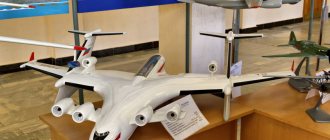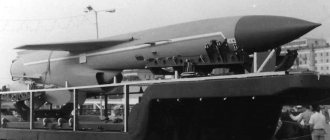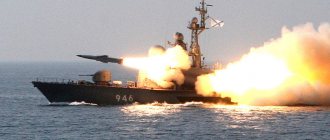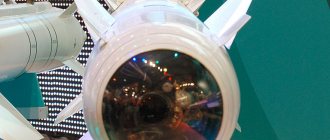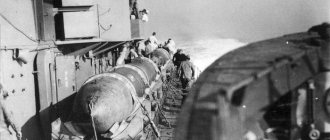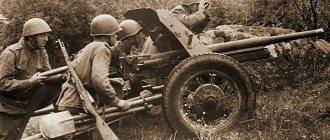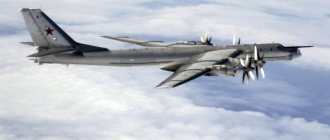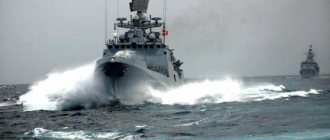Characteristics
| R-73 RMD-1 | R-73M RMD-2 | ||
| NATO designation | AA-11 Archer (Shooter) | ||
| Starting weight, kg | 105 | 110 | |
| Warhead mass, kg | 8 | 8 | |
| Warhead type | core | core | |
| Type of seeker | IR | IR | |
| Launch range, km: | maximum | 30 | 40 |
| minimum | 0,3 | ||
| Overload of targets hit | 12 | ||
| Own permissible overload | 40 | ||
| Probability of target hit | 0,6 | ||
| Length, mm | 2900 | ||
| Case diameter (caliber), mm | 170 | ||
| Plumage span, mm | 510 | ||
Table of missile launch ranges from the Su-27
Without taking into account the limitations of the seeker, the conditions are the carrier speed is 900 km/h, the target is 700, the target is straight ahead, no one is maneuvering. Ranges are given for different heights (10000, 5000, 1000) and angles (PPS 0/4 1/4 2/4 3/4, sideways 4/4, ZPS 0/4 1/4 2/4 3/4).
+———————————————————-+ | | | PPS |sideways|ZPS | | | |——————-| |——————-| |Rocket|Height|0/4 |1/4 |2/4 |3/4 |4/4 |0/4 |1/4 |2/4 |3/4 | |———————————————————-| |R-73 | 10000|17.5|16 |15 |13 |12 | 8.5| 9 | 9 |10 | |———————————————————-| |R-73 | 5000|13 |12.5|11.5| 9 | 8 | 6 | 6 | 6.5| 7.5| |———————————————————-| |R-73 | 1000| 9 | 8.5| 7.5| 6.5| 5.5| 4 | 4 | 4.2| 4.8| +———————————————————-+ // Table source - Valeri_
Developer and status:
The R-73, designated “Product 72,” was developed and put into service in 1983. (according to other sources - in 1985) at the Molniya NPO. However, in connection with the transfer of NPO to the development of the reusable spacecraft "Buran", in 1983, "Product 72" was transferred to the State Design Bureau "Vympel" for development and modernization. Currently, the R-73 is the main short-range missile of the Russian Air Force.
Carriers
: MiG-21-93, MiG-23ML, MiG-29, MiG-29M, MiG-29S, MiG-29K, Su-27, Su-27K, Su-25T, Yak-141.
Goals pursued by the development:
the creation of a weapon that would provide superiority in close, highly maneuverable combat, which, without limiting the maneuverability of a fighter, would allow the pilot to implement the rule: “See the enemy - shoot, shoot - forget.” Features of close air combat: large angular errors in missile launch at short ranges; the need to fire on oncoming and intersecting courses; high angular velocities of the target line of sight at the time of launch require the creation of a highly maneuverable missile capable of turning in the direction of the target immediately after launch with angles of attack up to 40°.
Purpose
: interception and destruction of highly maneuverable manned and unmanned enemy air attack and reconnaissance weapons in close air combat. It is possible to destroy automatic drifting balloons, cruise missiles and helicopters.
Conditions of use
: Ensures destruction of targets at altitudes up to 5 m at all angles (in the front and rear hemispheres of the target), day and night, in simple and adverse weather conditions, from any direction, in the presence of natural interference and with active electronic countermeasures of the enemy, against the background of ground and water surfaces. Does not impose restrictions on the initial launch conditions, completely autonomous.
Features of the R-73:
a rocket with combined aero-gas-dynamic control, combining the positive qualities of rockets with purely aerodynamic and purely gas-dynamic control: controllability in the passive phase of flight with the required tactical and technical characteristics and controllability and stabilization when flying at high angles of attack with the rocket engine running.
It significantly surpasses existing missiles of this type in its characteristics due to:
- no restrictions on flight modes and intensity of carrier maneuver;
- ensuring the possibility of shooting on oncoming and intersecting courses;
- simplicity and speed of aiming and target acquisition in the entire range of target designation angles, including an accidentally detected target on the pass from large angles at short range;
- greater maneuverability and ability to target a target at angular velocities of the target line of sight up to 60°/s and angular shooting errors up to 60°;
- absolute autonomy of the missile after launch, ensuring complete freedom of maneuver for the carrier to escape from the attack;
- the presence of guaranteed all-angle zones of possible launches against intensively maneuvering targets;
- high noise immunity of guidance and detonation systems from natural and organized interference, etc.
Literature
- Markovsky V., Perov K.
The missile finds its target. Soviet air-to-air missiles (Russian) // Wings of the Motherland. - M., 1995. - No. 10. - P. 10-11. — ISSNMedium range R-8 · R-4
R
-40
R
-
23 R-27
R
-77 (RVV-AE / RVV-SD)Long range R-33 · R-37 (RVV-BD)
KS -172Air-to-surface missiles Short range S-25LD · X-24
X
-23 (X-66)
X
-25
-
29
-
38Medium range KS-1 "Comet" · X-28
X
-58
X
-59
X
-15
-
31
X -45 X
-41
X
-35
X
” )
BrahMosLong range K-10S · KSR-11
X
-20
X
-22
KSR
-2
-
5
-
55 / X-555
/
X-102
- 90Unguided rockets Unguided rockets RS-82 · C-2
·
C-3K
·
C-5
·
C-8
·
C-13
·
C-21
·
C-24
·
C-25Unguided guided missiles S-5kor · S-8kor
S
-13korArranged in ascending order of development date. Italic experimental samples (not accepted for service) are highlighted.
This is a draft article about missile weapons. You can help the project by adding to it.
Modifications
The enterprises NPO Molniya and State Design Bureau Vympel have developed two versions of this missile:
R-73 RMD-1
and
R-73M RMD-2
, differing mainly in target designation angles: 45° for the RMD1 variant and 60° for the RMD2 variant. There is information that the RMD2 has an improved engine that practically doubles the maximum range in real combat conditions. The RMD's seeker, in addition to increasing target designation angles, has increased noise immunity against IR countermeasures and is built on a digital element base, which makes it easy to reprogram tracking and interception algorithms. Improved ability to attack low-flying targets.
R-73 Can be used to organize missile defense, allowing for the implementation of a reverse launch mode for the defense of the rear hemisphere of the carrier. There is also an export version: R-73E
.
A reverse launch rocket
was developed and tested on the basis of RMD2 .
Operators
Exporters of R-73 are three countries: Russia, Ukraine and Germany.
- Russia - R-73M[9]
- Algeria - 305 missiles delivered between 1999 and 2010[10]
- Ukraine
- Bangladesh
- Belarus
- Bulgaria
- Azerbaijan
- Hungary
- Vietnam
- Egypt
- India - 450 missiles delivered between 1999 and 2010[10]
- Iran
- Italy - 8 missiles delivered in the period 1999-2010[10]
- China
- DPRK
- Peru
- Poland - 318 missiles delivered between 1999 and 2010[10]
- Serbia
- Slovakia - 32 missiles delivered between 1999 and 2010[10]
- Eritrea - 5 missiles delivered between 1999 and 2010[10]
- Ethiopia
Design
A number of new technical solutions were used during development. In a rocket made according to an aerodynamic design
“canard” with destabilizers in the head part of the body and a traditional cruciform arrangement of aerodynamic surfaces on the nozzle part of the engine, an interceptor-type gas-dynamic control unit is installed, which creates a lateral force due to the deflection of the gas jet of the engine, which gives the missile high maneuverability, ensuring the destruction of targets maneuvering with overload up to 12 units. When the engine is running, control and stabilization of the rocket in pitch and heading are carried out by four aerodynamic rudders and four gas-dynamic spoilers connected in pairs for each channel. After engine operation ends, control and stabilization are carried out only by aerodynamic rudders. The rocket is stabilized in roll by four mechanically interconnected ailerons.
The missile is equipped with a small-sized passive infrared homing head
increased sensitivity and noise immunity with deep cooling of the photodetector, which captures the target in a suspension under the carrier. This head works out target designation angles up to 45° (60° for RMD-2), has coordinator pumping angles up to 75° and angular target tracking speed (angular speed of the line of sight) up to 60°/s.
Depending on the modification, the missile is equipped with a laser or radio fuse
.
Thanks to its TGS, the R-73 is one of the world's first all-aspect short-range missiles, capable of hitting targets not only on catch-up, but also on intersecting courses. The missile attacks a target at any initial position and allows it to intercept targets flying in a wide range of altitudes and speeds. Target designation for the homing head of the R-73 missile can be provided by the pilot’s helmet-mounted target designation system.
To increase the probability of hitting targets on intersecting courses, the homing head shifts the guidance point from the nozzle to the target fuselage.
The main material of construction is aluminum alloys, the engine housing is steel.
P-72 rail launcher is used for suspension under the carriers and launch of the rocket.
— with sequential exit of three yokes from the guides; aircraft suspension units are of the lug type. The equipment housed in this device makes it possible to use the missile from any modern aircraft without significant modification.
APU-73 aircraft launchers
, mounted on external underwing hardpoints.
An excerpt characterizing the R-73
But what is a case? What is a genius? The words chance and genius do not mean anything that really exists and therefore cannot be defined. These words only denote a certain degree of understanding of phenomena. I don't know why this phenomenon happens; I don't think I can know; That’s why I don’t want to know and say: chance. I see a force producing an action disproportionate to universal human properties; I don’t understand why this happens, and I say: genius. For a herd of rams, the ram that is driven every evening by the shepherd into a special stall to feed and becomes twice as thick as the others must seem like a genius. And the fact that every evening this very same ram ends up not in a common sheepfold, but in a special stall for oats, and that this very same ram, doused in fat, is killed for meat, should seem like an amazing combination of genius with a whole series of extraordinary accidents . But the rams just have to stop thinking that everything that is done to them happens only to achieve their ram goals; it is worth admitting that the events happening to them may also have goals that are incomprehensible to them, and they will immediately see unity, consistency in what happens to the fattened ram. Even if they do not know for what purpose he was fattened, then at least they will know that everything that happened to the ram did not happen by accident, and they will no longer need the concept of either chance or genius. Only by renouncing the knowledge of a close, understandable goal and recognizing that the final goal is inaccessible to us, will we see consistency and purposefulness in the lives of historical persons; the reason for the action they produce, disproportionate to universal human properties, will be revealed to us, and we will not need the words chance and genius. One has only to admit that the purpose of the unrest of the European peoples is unknown to us, and only the facts are known, consisting of murders, first in France, then in Italy, in Africa, in Prussia, in Austria, in Spain, in Russia, and that movements from the West to the east and from east to west constitute the essence and purpose of these events, and not only will we not need to see exclusivity and genius in the characters of Napoleon and Alexander, but it will be impossible to imagine these persons otherwise than as the same people as everyone else; and not only will it not be necessary to explain by chance those small events that made these people what they were, but it will be clear that all these small events were necessary. Having detached ourselves from knowledge of the ultimate goal, we will clearly understand that just as it is impossible for any plant to come up with other colors and seeds that are more appropriate to it than those that it produces, in the same way it is impossible to come up with two other people, with all their past, which would correspond to such an extent, to such the smallest details, to the purpose that they were to fulfill. The main, essential meaning of European events at the beginning of this century is the militant movement of the masses of European peoples from West to East and then from East to West. The first instigator of this movement was the movement from west to east. In order for the peoples of the West to be able to make the warlike movement to Moscow that they made, it was necessary: 1) for them to form into a warlike group of such a size that would be able to withstand a clash with the warlike group of the East; 2) so that they renounce all established traditions and habits and 3) so that, when making their militant movement, they have at their head a person who, both for himself and for them, could justify the deceptions, robberies and murders that were accompanied this movement. And since the French Revolution, the old group, not great enough, is destroyed; old habits and traditions are destroyed; a group of new sizes, new habits and traditions are developed, step by step, and the person who must stand at the head of the future movement and bear all the responsibility of what is to come is being prepared. A man without convictions, without habits, without traditions, without a name, not even a Frenchman, by the most strange accidents, it seems, moves among all the parties that worry France and, without attaching himself to any of them, is brought to a prominent place. The ignorance of his comrades, the weakness and insignificance of his opponents, the sincerity of the lie and the brilliant and self-confident narrow-mindedness of this man put him at the head of the army. The brilliant composition of the soldiers of the Italian army, the reluctance of his opponents to fight, his childish audacity and self-confidence gain him military glory. Countless so-called accidents accompany him everywhere. The disfavor into which he falls from the rulers of France serves to his advantage. His attempts to change the path destined for him fail: he is not accepted into the service in Russia, and he fails to be assigned to Turkey. During the wars in Italy, he is on the verge of death several times and is saved each time in an unexpected way. Russian troops, the very ones that could destroy his glory, for various diplomatic reasons, do not enter Europe as long as he is there. On his return from Italy, he finds the government in Paris in that process of decay in which the people who fall into this government are inevitably erased and destroyed. And for him there is a way out of this dangerous situation, consisting of a meaningless, causeless expedition to Africa. Again the same so-called accidents accompany him. Impregnable Malta surrenders without a shot; the most careless orders are crowned with success. The enemy fleet, which does not let a single boat through, lets through an entire army. In Africa, a whole series of atrocities are committed against almost unarmed inhabitants. And the people who commit these atrocities, and especially their leader, convince themselves that this is wonderful, that this is glory, that this is similar to Caesar and Alexander the Great, and that this is good.
Characteristics
The missile attacks a target flying in a range of altitudes
from 20m (5m for R-73M RMD-2) to 20km at a
speed
of up to 2500 km/h, at any initial position, in the range of target designation angles ±45° at angular speeds of the line of sight up to 60°/s.
The homing head can receive target designation from any sources of information: radar or optoelectronic sighting system, helmet-mounted target designation system, etc., which allows for further modernization to increase range, noise immunity and efficiency
In terms of the basic tactical and technical characteristics that determine the effectiveness of missiles in close air combat (maximum overload of targets hit, target designation angles, angular speeds of auto-tracking targets with a homing head, minimum launch ranges against maneuvering targets), the R-73 missile is superior to the best foreign analogues.
Notes
- Tikhonov, T.1, 2010, p. 96.
- Tikhonov, T.2, 2010, p. 160.
- Official website of JSC "Dux"
- Official website of the Tbilisi Aircraft Plant
- VC.
Babich. The fighters change tactics. - Moscow: Military edition, 1983. - ↑ 12
Short-range guided missile R-73 IS "Rocketry" BSTU - R-73 short-range guided missile | Rocketry
- The United States appreciated the new tactics of the Russian Mi-28 against Apache helicopters (unspecified)
. Russian newspaper (03/01/2020). Retrieved April 10, 2021. Archived April 10, 2022. - The International Institute for Strategic Studies IISS.
The Military Balance 2010. - Nuffield Press, 2010. - P. 228. - 492 p. — ISBN 9781857435573. - ↑ 123456
R-73 1999—2010 Report Archived January 4, 2013 on the Wayback Machine Deagel.com
